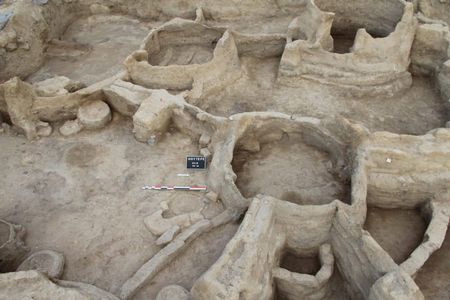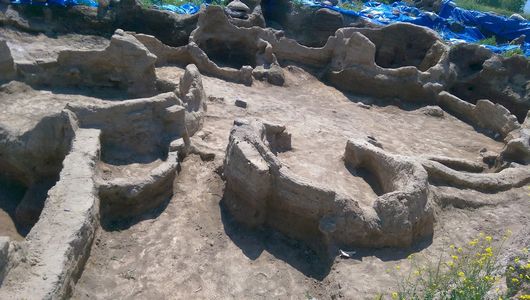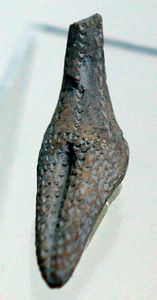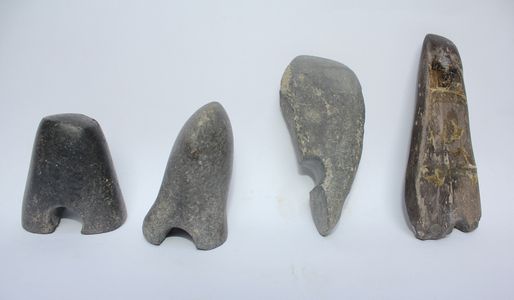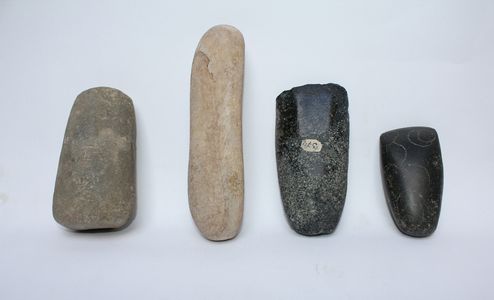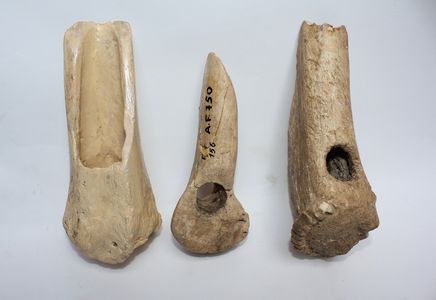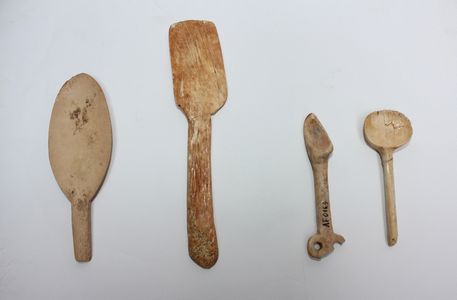MUDBRICK ARCHITECTURE IN CIRCULAR PLAN
Neolithic (a Greek word standing for νέος «new», λίθος «stone») means “new stone” age. Early producing industry had been established in the whole South Caucasus including Azerbaijan during Neolithic period spanning 7th-6th millenniums BC. Gathering and hunting shaped the consumption industry had gradually became peripheral fields of economy. Sedentary farming and cattle-breeding developed and producing tools made of stone and bone were used in this period. Along with the emergence of producing industry, there was a control over producing tools and common product. This turning period throughout the mankind history resulted in producing, farming-cattle breding industry is known as “Neolithic Revolution”. “Mohre” houses (the houses built with the mix of mud and clay) and the first farming settlements emerged during this period. Inhabitants of these settlements mastered polishing, boring of stone, production of clay vessels and began weaving. Neolithic period monuments include ancient habitations located in Ganja-Qazakh, Nakhchivan and Karabagh regions, Hasanli, Haji Firuz, Yanigtepe etc. in Lake Urmia basin in the South Azerbaijan and in neighboring Zagros territory.
The process of settlement of early farmer-cattle breeder tribes over the wider area had occurred in the Neolithic period. These tribes dwelled in the South Caucasus especially in productive plain areas in the south of Kur River usually on the shore of water basins. Neolithic habitations in Azerbaijan were normally small encompassing 0.5 ha area. Generally, constructions in all settlements were very close to each other. Neolithic tribes mainly lived in mudbrick houses in circular plan. Sometimes the walls of houses were cylindric, in some cases, they were built upward. The ceiling was supported by a special pillar set to the floor. The houses had one sometimes two entrances. Hearths for heating houses were at the bottom of the wall. The diameter of buildings was maximum 3.7 meters. The remnants of rectangular houses as well as round and semi-round houses were found out in Ilanlitepe. Clay plaster sometimes mixed with paint was rendered on the floors of constructions and the walls were patterned with paint.
EARLY FARMING AND CATTLE-BREEDING
In Neolithic period, the suitable location of habitations for farming and cattle-breeding is associated with the formation of producing industry. Hoe-like tools, graters, microliths used as sickle teeth uncovered from these settlements indicate the development of farming that was one of the main fields of producing industry. The discovery of plenty of hoes from early farming settlements located particularly on Ganja-Gazakh plain evidence the blossoming of hoe-farming culture in the Neolithic period. The hoe was digging and plowing tool of ancient farmers. Hoes were made of deer horns, leg and shoulder bones of cattle. Farmer tribes cultivated various kinds of grain, made tools for planting and reaping, gathered the harvest, threshed and consumed them. Domestication of animals was an impetus to the growth of cattle-breeding that was one of the basic fields of producing industry. Cattle-breeding economy was composed of most of the main domestic animals. During that period, the existence of various breeds of bull, sheep, horse and pig in the flock of people’s domestic animals proved that the cattle-breeding had already reached the highest level of development. Products of farming and cattle-breeding were the primary food source of Neolithic tribes lived in Azerbaijan.
CULTURAL RELATIONS: HALAFIAN VESSELS
Early farming culture of Azerbaijan had developed due to the mutual relations with neighboring regions of the Caucasus and Western Asia. Archeological findings indicate that throughout the whole Neolithic period, early farmer-cattle breeder tribes of Azerbaijan had relations with Mesopotamian tribes. Fragments of painted eartherware confirming the relations with Halaf archeological culture bearers of the South Caucasus were found out from the lower cultural layer of I Kultepe settlement in Nakhchivan.
MATRIARCHY
Due to the funeral customs, domestication of animals, cultivation of cereals and the improvement of different kinds of handicraft, cognitive ability of prehistoric human had considerably developed. Therefore, new rites emerged, the language enriched and people’s beliefs became more complicated. The figures reflecting the human image revealed in the settlements of Azerbaijan give some information on ideological beliefs of early farmers. Painted head of human figure made of stone was discovered from Yanigtepe. Its eyes were in black. The fragments of clay female figure and other human figures were acquired from Haji Firuz settlement. The figures found out from Chalaghantepe were superbly decorated. The necklace, belts, hair braids on them verify that these figures belonged to woman. The figures were incomplete and didn’t have arms and legs. There were wavy lines reflecting female braids all over the figure uncovered from Garghalartepesi. These lines were drawn horizontally on the legs. Almost all known anthropomorphic figures belonged to woman and emboided the idea of productivity. All these findings point out that there was female dominance and worship of woman in the societies of Neolithic period.
HANDICRAFT IN NEOLITHIC PERIOD
Stonework and bone working
There existed different types of handicraft during the Neolithic period. Along with traditional professions like making stone and bone articles, leatherwork, novel producing fields had been developing. Previous technical methods were applied to make stone articles. During this period, splintering and pressure retouching methods were widely used for making tools. People mastered the techenique of boring and polishing stone. It gave rise to significant innovations in the economy and daily life. Stone tool was firstly splintered, shaped, engraved with pressure retouching method and polished. Local fields of obsidian and flint were utilized for making tools. The examinations of the tools found from settlements demonstrate that ancient farmers used Paravan obsidian field, Ilanlitepe and Alikomektepe residents used Kalbajar field, and I Kultepe residents used the fields of Goyem and Zangazur mountains. The growth of cattle-breeding impacted positively the development of bone working during Neolithic period. Thus, there was a wide range of products made of domestic animals with big and small horns including hoe, sickle, grinding, boring articles, awl, needle, spoon, arrowhead, spindle, pendant etc. other articles. In a word, the influence of cattle-breeding could be observed in farming, military, handicraft and household fields of prehistoric society.
Pottery
Pottery had a special place among the various types of handicraft in course of formation and development of producing industry. People’s growing demand made the increase of producing clay vessels necessary and it, in turn, resulted in making particular pottery kilns. Remnants of such pottery kilns were discovered in I Kultepe, Shomutepe, Ilanlitepe, Alikomektepe, Chalaghantepe. Among them, there were two-layered kilns, too. The fuel was put on the lower layer and the clay vessels on the upper layer. The fire got into the upper chamber, where the clay vessels were put, through the hallows of fuel chamber and holes on the roof. Kitchen utensils and probably big pitchers were baked in those kilns. Some ceramics were made of clay which was a mix of plant and hay and some of them had netted bottoms. All vessels were handmade. They were narrow, thick-walled, rough in shape and not well-baked. There were pieces replacing handles on some big pitchers. The jugs with ordinary handles were found only from Alikomektepe settlement. Potteries uncovered from southern regions of Azerbaijan were in light red color, polished, made of clay mixed with plant, covered with slip and had wide bottom. They were patterned with paint and sometimes had artificial decorations. The potteries of the provinces of Azerbaijan located around Lake Urmia differ for their variety and technical excellence. The potters of Dalmatepe settlement had reached high level of sophistication and made magnificent painted potteries. The most ancient exemplars of painted potteries were discovered from Haji Firuz settlement in the 6th millennium BC.
Metalworking
According to copper articles, we could reason that Neolithic period tribes of Azerbaijan had already got acquainted with metal. A bead made of copper board was found from Garghalartepesi settlement, two copper beads and awls from Alikomektepe, fragments of three copper articles from Goytepe in Urmia. A piece of knife blade is one of the findings revealed in Goytepe. Great amount of metal including three articles made of copper-arsenic mix was discovered from the most ancient cultural layer of I Kultepe. Four-edged awl, rhombic board, two beads and the fragments of three unknown articles were also found from that layer. Cold and hot forging techniques of copperworking were used during this period. The discovery of articles made of copper-arsenic mix from Kultepe, a clay vessel used for melting copper and pottery ladle from Khantepe indicate that ancient tribes had already known about metalworking and metal melting in this period.
Weaving
There were spindle heads made of stone, bone and clay related to the weaving and the traces of the finest fabric in some monuments of Azerbaijan concerning the last stage of Eneolithic period. People of Eneolithic period usually made matting, basket and other products of reed. There were often found out matting remains on the floors of houses. Sometimes dead bodies were wrapped with mat. Clay vessels with weaving traces on their bottoms were discovered in several monuments of Azerbaijan.
